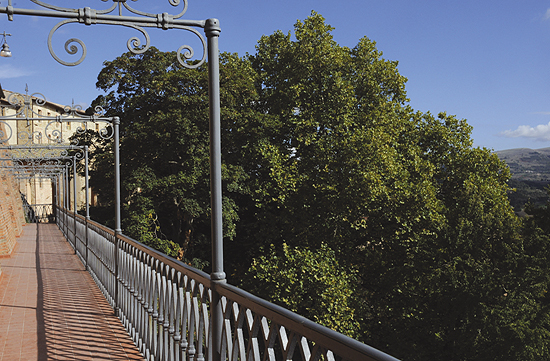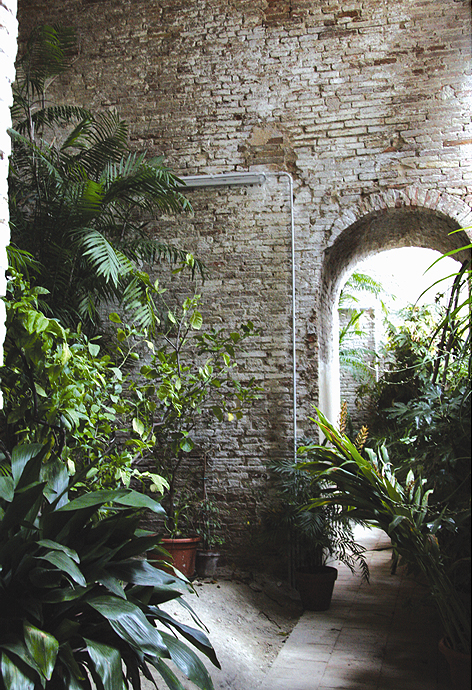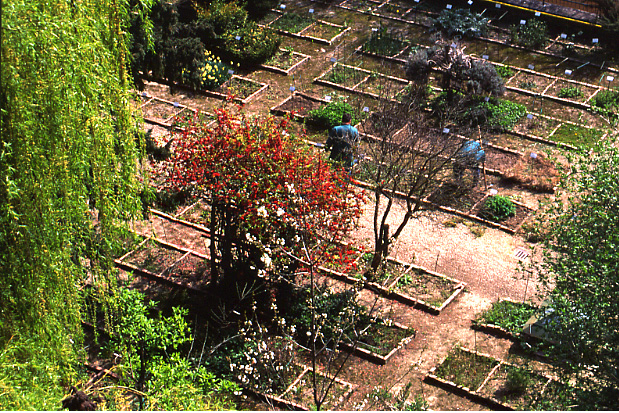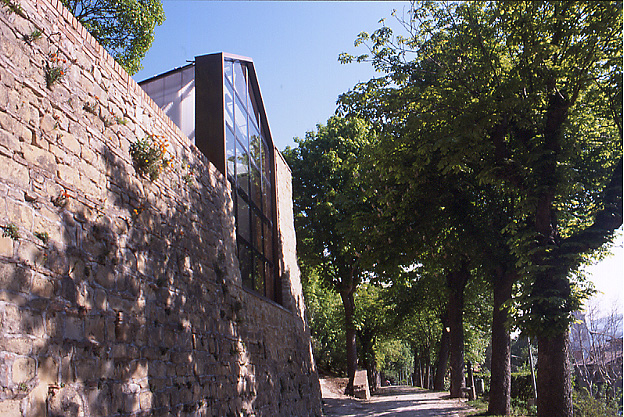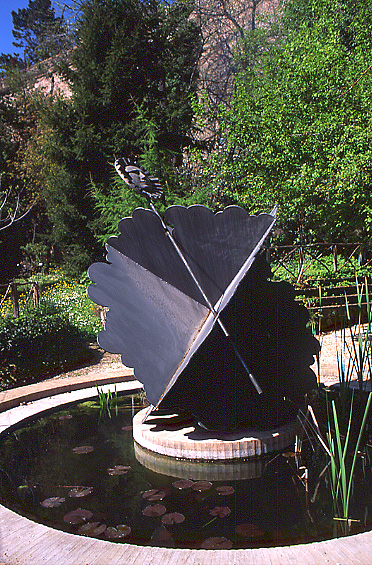
“Carmela Cortini” – University of Camerino Botanical Garden
This post is also available in:
 Italiano (Italian)
Italiano (Italian)
This botanical garden was established in 1828 by Vincenzo Ottaviani, Professor of Botany at the Faculty of Medicine at the University of Camerino. He chose an area with pre-existing gardens and uncultivated patches, on the edge of the historical centre of town.
An inventory of 1835 shows that 1096 trees and shrubs were cultivated there, in addition to those along the avenues, and 887 ground and pot plants.
Born as an instructional for the university, the garden now contributes to the conservation of endangered species and the dissemination of scientific culture – also offering valuable support to schools, students and teachers.
Facing south-east towards the Sibillini Mountains, the garden covers 2.5 acres at the foot of the walls of the Doge’s Palace, 88 ft below the city; it can be accessed both from viale Oberdan and from the overhanging Renaissance loggias of the Doge’s Palace, known as “Loggette dei Governatori” – by a famous spiral staircase of 106 steps built by Pope Pius V in 1568; in the middle of the staircase, there are two rooms used as classrooms for exhibitions and activities.
At the base of the staircase and along the garden perimeter walls, there are natural caves (called “grottoni”), partly dug in the sandstone banks which are also the foundations of the Doge’s Palace.
The Garden is divided into two main sections: the one located on a slope, with a XIX century layout and centuries-old trees arranged in a grove, and the flat one, planted with herbaceous, shrub and tree species divided into themed areas. Two circular fountains decorate the garden along with a XIX century terracotta statue and Gino Marotta’s “Vegetal Universe” ironwork.
Since 2012, the Garden has been acknowledged as a Monumental Plant Formation by the Marche Region, thanks to its tree specimens that date back to the time of its very creation.
Plants
Despite its small size, this garden has a remarkable variety of different environments.
In the flat part, officinal plants (including Datura stramonium, Atropa belladonna, Hyssopus officinalis aristatus) are cultivated in square flower beds, along with spontaneous and ornamental species.
The spontaneous species belong to the typical flora of the central Apennines (Apennine rocks), the flora of the sub-vertical limestone wall, the garrigue, the pond, the tree and shrub species of the central Apennines. Other flower beds are used for bulbous varieties.
-Among the spontaneous plants, there are Cardamine monteluccii, Juniperus sabina, Asphodeline liburnica, and Arum lucanum.
Aquatic plants include Acorus calamus, Menyanthes trifoliata, Caltha palustris, Azolla filiculoides, Carex caespitosa, and Carex appropinquata.
-In south-facing crack, there are Festuca dimorpha, Galium magellense, Cymbalaria pallida, and Drypis spinosa;
-A small humid wall facing north features Soldanella alpina, Soldanella minima samnitica, and the Majella endemic species Ranunculus magellensis, Aquilegia magellensis, and others.
-Among the species of the Apennine rock, there are Centaurea tenoreana (endemic to Majella), Centaurea scannensis, Achillea barrellieri, Achillea oxyloba subsp. mucronulata, Arctostaphylos uva-ursi, Saxifraga porophylla porophylla, Saponaria bellidifolia, Leontopodium alpinum nivale, Edrajanthus graminifolius graminifolius, Aubrieta columnae columnae, Viola eugeniae eugeniae, etc.
– Among the species of the alpine garrigue, there are several plants mainly originating from the hills around Camerino such as Cistus creticus eriocephalus, Cistus salviifolius, Cistus monspeliensis, Artemisia alba, Sideritis italica, Gagea granatellii, Romulea columnae, Romulea bulbocodium, Biarum tenuifolium , Asphodeline lutea, and various species belonging to the Orchidaceae family like Aceras antropophorum, Orchis purpurea, Orchis morio, Orchis pauciflora, Ophrys sphecodes, and Ophrys crabronifera crabronifera.
Along the slopes, wildflowers have been sown, such as Anthriscus nemorosa and Ranunculus lanuginosus.
-In the arboretum near the entrance, there are Carpinus betulus, Ostrya carpinifolia, Corylus avellana, Alnus cordata, Fraxinus excelsior excelsior, Populus tremula tremula, Sorbus aucuparia aucuparia, Sorbus torminalis Rhamnus cathartica, Ulmus minor subsp. minor, Crataegus monogyna monogyna, Spartium junceum, and Ruscus aculeatus.
-Other flower beds are dedicated to the genera Helleborus, Peony and Hydrangea.
-Among exotic tree species, there are Ginkgo biloba, Gleditschia triacanthos, Parrotia persica, Liriodendron tulipifera, and Sequoiadendron giganteum; among those belonging to the spontaneous flora, there are Quercus ilex, Quercus cerris, Quercus petraea, Taxus baccata, Celtis australis, Pinus laricio, and Fagus sylvatica – at their feet, there is an area dedicated to the ferns of the central Apennines, such as Polypodium cambricum serrulatum, Poypodium vulgare, Asplenium onopteris, Phyllitis scolopendium, Athyrium filix-foemina, Polystichum lonchitis, Polystichum aculeatum, and Polystichum setiferum.
-The warm greenhouses host tropical and subtropical species, with succulents and epiphytes (genera Begonia and Tillandsia, Kalanchoe beharensis, Stanhopea tigrina, Orchidaceae, Nepenthes phyllamphora, Cynammonum camphora, Piper nigrum, etc.).
-Finally, two terrarium-aquariums have recently been created for the cultivation on sphagnum of carnivorous plants such as Dionea muscipula, Drosera capensis, Drosera rotundifolia, Drosera binata, Nepenthes sanguinea, Sarracenia purpurea, and Pinguicula moranensis.
The hanging garden
Close to the walls of the Doge’s Palace, on a raised level, there is a hanging garden, as also shown in the first garden map created by Giovanni Filippini in 1829. In this Italian garden, in addition to a nice view of the landscape surrounding Camerino, some varieties of fragrant ancient roses are grown.
This post is also available in:
 Italiano (Italian)
Italiano (Italian)
Contatti
Via Oberdan S/N - I - Camerino (MC)(MC)
0737 403084 e 0737 403100
ortobotanico@unicam.it
https://sma.unicam.it/it/orto-botanico
Altre info
Ingresso gratuito. Visite guidate a pagamento
dal Lunedì al Venerdì dalle ore 9,00 alle ore 13,00/ dalle ore 15,00 alle ore 17,00 Dal 14 Aprile al 16 Settembre aperto anche: Sabato e Domenica dalle ore 10,00 alle ore 13,00/ dalle ore 16,00 alle ore 19,00 Crea un appuntamento
dal Lunedì al Venerdì dalle ore 9,00 alle ore 13,00/ dalle ore 15,00 alle ore 17,00 Dal 14 Aprile al 16 Settembre aperto anche: Sabato e Domenica dalle ore 10,00 alle ore 13,00/ dalle ore 16,00 alle ore 19,00 Crea un appuntamento
